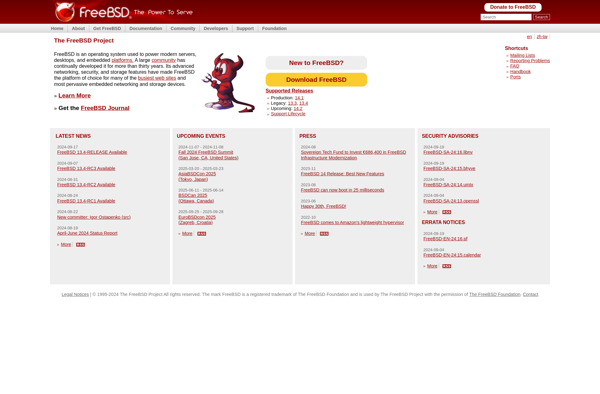HP-UX
HP-UX is a proprietary Unix operating system developed by Hewlett Packard Enterprise (HPE). It runs on HP's Intel Itanium-based servers and is designed for mission-critical workloads and high availability.

HP-UX: Proprietary Unix Operating System
A mission-critical operating system running on Intel Itanium-based servers, designed for high availability and critical workloads.
What is HP-UX?
HP-UX is a proprietary Unix operating system developed and maintained by Hewlett Packard Enterprise (HPE). It runs exclusively on HP's line of Intel Itanium-based servers.
First released in the 1980s, HP-UX is known for its stability, reliability and security features designed for mission-critical workloads. It implements robust virtualization capabilities allowing multiple operating system images to share hardware resources.
Key features of HP-UX include:
- Advanced workload partitioning for increased utilization
- Integrated virtualization for hosting multiple applications
- High availability clustering to minimize downtime
- Advanced security modules for access control and encryption
- Enterprise-grade toolset for systems management
HP-UX Features
Features
- Kernel-based virtualization
- Logical partitioning
- Workload management
- High availability clustering
- Disaster recovery
- Security features like Access Control Lists and auditing
Pricing
- One-time Purchase
- Subscription-Based
Pros
Very reliable and stable
Good performance for enterprise workloads
Long product lifecycle support
Integrates well with other HP enterprise products
Cons
Only runs on expensive Itanium hardware
Limited adoption outside of existing HP customers
Not as feature rich as Linux alternatives
Future is uncertain due to decline of Itanium
Official Links
Reviews & Ratings
Login to ReviewThe Best HP-UX Alternatives
Top Os & Utilities and Unix Operating Systems and other similar apps like HP-UX
Here are some alternatives to HP-UX:
Suggest an alternative ❐Ubuntu
Ubuntu is one of the most popular Linux distributions available today. It is based on Debian and completely free and open source. Some key points about Ubuntu:It has an easy to use and intuitive interface, making it great for Linux beginners.It has a wide variety of official flavors featuring different...

Debian
Debian is one of the oldest and most popular Linux distributions available today. First released in 1993, it is known for its stability, commitment to free software principles, and huge repository of over 50,000 software packages.Some key facts about Debian:It is developed by a worldwide community of volunteers working together...

Puppy Linux
Puppy Linux is a lightweight Linux distribution that is designed to run well on older computers with limited resources. Some key features of Puppy Linux include:Very small download size, usually under 300 MBCan run entirely from RAM for better performanceEasy to use graphical interface and toolsCompatible with Ubuntu software packagesMany...

Manjaro Linux
Manjaro Linux is an open source, independently developed GNU/Linux distribution based on Arch Linux. It aims to provide an accessible entry point for new Linux users, while maintaining the DIY spirit and technical simplicity that Arch Linux is known for.Some key features of Manjaro Linux include:User-friendly graphical installers for quick...

Deepin
Deepin is a Linux distribution developed in China that focuses on an intuitive and aesthetically pleasing user experience. It is based on Debian and uses the Deepin Desktop Environment (DDE), which is developed in-house. Some key features of Deepin include:Custom desktop environment (DDE) designed for an intuitive user experience. Includes...

FreeBSD
FreeBSD is an advanced open source computer operating system used for modern servers, desktops, and embedded platforms. Originally derived from BSD Unix, FreeBSD offers compatibility with a wide range of applications and drivers while providing advanced performance, security, and networking features.Some key aspects of FreeBSD include:Excellent stability and reliability based...

OpenSUSE
openSUSE is a versatile Linux distribution that can be used on desktops, laptops, and servers. It focuses on being easy to use, having up-to-date software packages, and providing flexibility for different types of users.Some key features and information about openSUSE:Sponsored by SUSE Linux and other companies, but community-developedRegular release cycle...

Pop!_OS
Pop!_OS is a Linux distribution developed by computer manufacturer System76. It is based on Ubuntu and uses the GNOME desktop environment.Some key features of Pop!_OS include:Custom GNOME desktop theme and system improvements designed for an optimal workflow.Good hardware compatibility, especially with System76 hardware.Streamlined window and workspace management using keyboard shortcuts...

Red Hat Enterprise Linux
Red Hat Enterprise Linux (RHEL) is a Linux distribution developed by Red Hat focused on stability, reliability, long-term support, and security for enterprise use. Some key features of RHEL include:Long term support releases with 10 years of maintenance and updates providedCertification for running business-critical applications and workloadsAdvanced package management using...

NixOS
NixOS is a Linux distribution that aims to improve the state of Linux package management and system configuration. Some key features and goals of NixOS include:Reliability - NixOS utilizes atomic upgrades and rollbacks to ensure a reliable system state. If an upgrade fails, the system can automatically roll back to...

OpenBSD
OpenBSD is a free and open-source Unix-like operating system derived from BSD. It focuses on security, code correctness, and cryptography implementations.Some key features and characteristics of OpenBSD:Strong focus on security through default secure configuration, proactive security features like W^X, ASLR, etc.Frequent code auditing and cleaning to remove bugs and potential...
